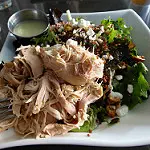Reduce Fatty Foods
If you are wondering about the best ways to make lean muscle mass gains, start with lowering your consumption of fatty foods.
Aim to decrease your fatty foods intake so that it’s no greater than 20% of your everyday calorie consumption.
Image by Natalia Robba via Flickr
… But Increase Healthy Unsaturated Fats
We additionally suggest that you restrict your choice to healthy and balanced unsaturated fats.
It’s interesting to note that individuals who significantly limit their fat consumption (below the 20% level) will not look healthy and balanced; their hair will certainly be breakable, their skin will certainly be completely dry, and they will have a tendency to be cranky and subject to a lot of mood swings.
Eliminate Empty Carbs
You must also eliminate “empty” carbs, as well. For example, foods that are extremely high in sugar however do not have nutrients, such as cookies, candies, candy bars, as well as various other processed and refined foods.
Reducing those empty carbs will certainly make you really feel healthier in general, provide you a lot more power and energy, and will enable you to obtain the nutrients that you need to create lean muscle mass.
Get Your Lean Meats and Veggies
The most effective lean muscle building regimens correspond to reduced carbohydrate diet regimens, though we want you to take a less extreme approach. You will require carbs so that you have sufficient power to workout, especially if you are lifting weights.
Focus on foods that are high in healthy protein, like meat (such as skinless hen busts and also lean beef), nuts, as well as some vegetables, along with on veggies.
The healthy protein foods will help your body develop muscular tissue mass, while the veggies will provide you the nutrients and fiber that will maintain you health and lose fat.
With this diet plan, you can get and stay full by eating almost an unlimited amount of green, leafy vegetables. Fiber-rich vegetables will help you to feel full without worrying too much about caloric intake.

Image by Rev. Voodoo via Flickr
Tracking and Tweaking Your Foods and Macro-Nutrients
We suggest that you maintain a food journal for one week and afterwards evaluate your regular calorie consumption.
First, track all your macronutrients (inlcluding fat, protein, and carbs) for at least one week.
After you know your baseline, minimize the calories by 15% in order to shed fat.
If you want to gain lean muscle mass, you will also need to raise your calories by 15%.
Consume Natural and Organic Foods
A lot of people in the fitness industry rely on protein shakes and bars, me included. While those could aid you in some cases – specifically by enabling you to increase the amount of healthy protein in your diet regimen – you should not rely on them too heavily.
Aim to eat 80% of your protein requirements through real, whole, unprocessed foods. Prepare the food on your own from scratch, preferably with organic, natural, and raw components.
Lower the Glycemic Load
Reduced glycemic foods are the healthiest food option. The Glycemic Index is a measure of just how much your blood glucose (sugar) increases after consuming carbohydrate foods.
High glycemic foods trigger a rise in blood glucose, therefore increasing your insulin — resulting in feeling hungrier faster, which will result in a tendency to overeat.
High Glycemic foods are most grains as well as grain items (both wheat and white), cookies, sweets, candy bars, breakfast cereals, grain based processed snacks such as tortilla chips, corn, white potatoes (these are very starchy foods), bananas, dried fruits including exotic and tropical fruits, fruit juices, honey, and of course table sugar.
Reduced Glycemic foods are vegetables (including lentils, chickpeas, kidney beans, and also the majority of various other beans), fruits such as cherries, blackberries and other berries, plums, peaches, grapes, as well as dairy items such as milk, yogurt, and kefir. Other reduced glycemic foods include non-starchy veggies such as broccoli, Swiss chard, bok choy, lettuce, celery as well as kale.
Getting Results!
If you follow these principles, you will develop a more powerful, leaner physical body. You will also benefit from many side advantages of shedding fat: physical and mental toughness, enhanced power, increased endurance, a smaller midsection, noticeably sexier abdominals, as well overall improved wellness!


